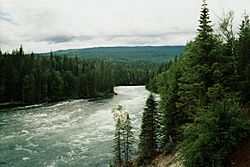Baileys Chute facts for kids
Quick facts for kids Baileys Chute |
|
|---|---|

Elevated view of Baileys Chute
|
|
| Lua error in Module:Infobox_mapframe at line 185: attempt to index field 'wikibase' (a nil value). | |
| Location | Wells Gray Provincial Park, British Columbia, Canada |
| Coordinates | 52°04′27″N 120°11′58″W / 52.07417°N 120.19944°W |
| Type | Gradual sliding cascade |
| Total height | 9 m (30 ft) |
| Number of drops | 1 |
| Total width | 61 m (200 ft) |
| Average width | 46 m (151 ft) |
| Run | 61 m (200 ft) |
| Watercourse | Clearwater River |
| Average flow rate |
122 m3/s (4,300 cu ft/s) |
Baileys Chute, often misspelled Bailey's Chute, is one in a series of small waterfalls along the Clearwater River in Wells Gray Provincial Park, British Columbia, Canada. With an average high flow rate of 122 m3/s (4,300 cu ft/s), it is one of the largest waterfalls in British Columbia.
Contents
Name origin
Baileys Chute is named after Jim Bailey, an engineer who drowned in 1952 after his canoe capsized in the river just downstream of the falls.
Structure
The falls take the form of a gradual sliding cascade. The force of the water impacting the river produces a 1.5 metre tall standing wave that propagates downstream from the falls. This indicates the presence of a significant undercut in the riverbed with an estimated depth of 30 m (98 ft).
Salmon
Baileys Chute is a good place to view the Chinook as they try to leap the falls from mid-August through September. They are the largest of the Pacific salmon, weighing from 8 kg to 22 kg. Most spawn at The Horseshoe further downstream after a life cycle of four to six years.
External links

